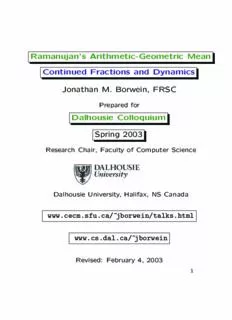
Ramanujan's Arithmetic Geometric Mean Continued Fractions and Dynamics Dalhousie Colloquium PDF
Preview Ramanujan's Arithmetic Geometric Mean Continued Fractions and Dynamics Dalhousie Colloquium
Ramanujan’s Arithmetic-Geometric Mean Continued Fractions and Dynamics Jonathan M. Borwein, FRSC Prepared for Dalhousie Colloquium Spring 2003 Research Chair, Faculty of Computer Science Dalhousie University, Halifax, NS Canada www.cecm.sfu.ca/~jborwein/talks.html www.cs.dal.ca/~jborwein Revised: February 4, 2003 1 Srinivasa Ramanujan (1887–1920) • G. N. Watson (1886–1965), on reading Ra- manujan’s work, describes: a thrill which is indistinguishable from the thrill I feel when I enter the Sagres- tia Nuovo of the Capella Medici and see before me the austere beauty of the four statues representing ‘Day,’ ‘Night,’ ‘Evening,’ and ‘Dawn’ which Michelan- gelo has set over the tomb of Guiliano de’Medici and Lorenzo de’Medici. 2 1. Abstract The Ramanujan AGM continued fraction a R (a, b) = η 2 b η + 2 4a η + 2 9b η + η + ... enjoys attractive algebraic properties such as a striking arithmetic-geometric mean relation & elegant links with elliptic-function theory. • The fraction presents a computational challenge, which we could not resist. • Joint work with Richard Crandall and vari- ously D. Borwein, G. Fee, R. Luke and R. Mayer. 3 ♣ Much of this work is to appear in Experi- mental Mathematics [CoLab Preprints 27, 29 and 253.] 1. In Part I: we show how to rapidly eval- uate R for any positive reals a, b, η. The problematic case being a ≈ b—then subtle transformations allow rapid evaluation. • On route we find, e.g., that for rational a = b, R is an L-series with a ’closed- η form.’ • We ultimately exhibit an algorithm yield- ∗ ing D digits of R in O(D) iterations. 2. Finally, in Part II of this talk, we address the harder theoretical and computational dilemmas arising when parameters are al- lowed to be complex. ∗The big-O constant is independent of the positive-real triple a,b,η. 4 2. Preliminaries PART I. Entry 12 of Chapter 18 of Ramanu- jan’s Second Notebook [BeIII] gives the beau- tiful: a R (a, b) = (1.1) η 2 b η + 2 4a η + 2 9b η + η + ... which we interpret—in most of the present treatment—for real, positive a, b, η > 0. Remarkably, for such parameters, R satisfies an AGM relation (cid:181) (cid:182) √ a + b R (a, b) + R (b, a) η η R , ab = (1.2) η 2 2 5 1. (1.2) is one of many relations we develop for computation of R . η 2. “The hard cases occur when b is near to a,” including the case a = b. 3. We eventually exhibit an algorithm uniformly of geometric/linear convergence across the positive quadrant a, b > 0. 4. Along the way, we find attractive identities, such as that for R (r, r), with r rational. η 5. Finally, we consider complex a, b—obtaining theorems and conjectures on the domain of validity for the AGM relation (1.2). 6 Research started in earnest when we noted R (1, 1) 1 ‘seemed close to’ log 2. Such is the value of exper- iment: one can be led into deep waters. As discussed in Chapter One of Experimentation in Math- ematics. • A useful simplification is R (a, b) = R (a/η, b/η), η 1 as can be seen by ‘cancellation’ of the η elements down the fraction. Such manipulations are valid because the continued converges. 7 To prove convergence we put a/R in RCF 1 (reduced continued fraction) form: a R (a, b) = (2.1) 1 [A ; A , A , A , . . . ] 0 1 2 3 a := 1 A + 0 1 A + 1 1 A + 2 A3 + ... where the A are all positive real. i a It is here that both the profundity and limitations of Ramanujan’s knowledge stand out most sharply. (G.H. Hardy) a Ramanujan’s work on elliptic and modular functions. 8 • Inspection of Ramanujan’s pattern in R yields the RCF elements explicitly and gives the asymptotics of A : n For even n 2 n n n! b 2 b −n A = 4 ∼ . n (n/2)!4 an π n an For odd n 4 n−1 n ((n − 1)/2!) a π a n−1 A = 4 ∼ . n n!2 bn+1 2 ab n bn • This representation leads immediately to: Theorem 2.1: For any positive real pair a, b the fraction R (a, b) converges. 1 (cid:80) Proof: An RCF converges iff A diverges. i (This is the Seidel–Stern theorem [Kh,LW].) In our case, such divergence is evident for every choice of real a, b > 0. (cid:176)c 9 (cid:80) • Note for a = b, divergence of A is only i logarithmic —a true indication of slow con- vergence (we wax more quantitatively later). • Indeed, our interest in computational as- pects started with asking how, for positive a, to (rapidly) evaluate R(a) := R (a, a) 1 and thence to prove suspected identities. • We shall later encounter a different con- tinued fraction for R(a), as well as other computationally efficient constructs. 10
